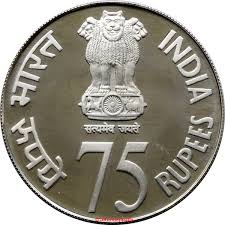On May 28, Prime Minister Narendra Modi released a special commemorative coin with a denomination of Rs 75 to mark the inauguration of the new Parliament building in India. Commemorative coins have a long history in India and are issued by the government to honor notable personalities, promote cultural heritage, and commemorate important events. The newly released Rs 75 coin holds both symbolic and numismatic significance, representing the nation’s cultural and democratic heritage. In this article, we will explore the features of this commemorative coin, its significance, the process of obtaining it, and delve into the broader context of commemorative coins in India.
Features of the New Commemorative Coin
The new Rs 75 commemorative coin showcases unique design elements that reflect India’s rich cultural and national identity. The coin is circular in shape with a diameter of 44mm, making it larger than regular circulation coins. It is composed of a quaternary alloy consisting of 50% silver, 40% copper, 5% nickel, and 5% zinc. This composition adds to the coin’s intrinsic value and makes it a sought-after collectible among numismatists and coin enthusiasts.

On the obverse side of the coin, the prominent feature is the Lion Capitol of Ashoka Pillar, which is a well-known symbol of India’s rich history. The Lion Capitol is an architectural element from the Ashoka Pillar, which is a national emblem of India. It represents Ashoka’s commitment to truth and righteousness. Below the Ashoka Pillar, the inscription “सत्यमेि जयते” (Satyameva Jayate), meaning “Truth Alone Triumphs” in Devnagri script, is displayed. The word “भारत” (Bharat) in Devnagri script appears on the left periphery, emphasizing India’s national identity. On the right periphery, the word “INDIA” is inscribed in English, symbolizing India’s global presence.
The reverse side of the coin showcases an image of the new Parliament building, which is an architectural marvel and a symbol of India’s democratic heritage. The Parliament Complex, with its distinct design, represents the functioning of the world’s largest democracy. The upper periphery of the coin bears the inscription “Sansad Sankul” in Devnagri script, highlighting the importance of the Parliament Complex. Additionally, the words “Parliament Complex” in English and the year “2023” in international numerals are displayed on the lower periphery of the coin, signifying the historical significance of the inauguration.
Significance of Commemorative Coins
Commemorative coins hold significant importance in preserving the historical, cultural, and political heritage of a nation. They serve as tangible reminders of remarkable individuals, important events, and significant milestones. In the case of the Rs 75 commemorative coin, it serves as a marker of the momentous occasion of the new Parliament building’s inauguration.
Commemorative coins are not intended for circulation like regular currency. Instead, they are minted with a specific purpose, such as honoring national heroes, celebrating achievements, or promoting cultural and historical awareness. They provide a tangible link between the past and the present, acting as ambassadors of a nation’s heritage and values.
In India, the government has been issuing commemorative coins since the 1960s for various reasons. These coins pay homage to notable personalities who have made significant contributions to the country in diverse fields, including politics, arts, science, and social
reform. They also highlight key historical events, raise awareness about government initiatives, and promote cultural heritage.
One important aspect to note is that commemorative coins often have a higher intrinsic value due to their composition, which may include precious metals such as gold or silver. While their face value may be nominal, their precious metal content adds to their worth in the collectors’ market. As a result, commemorative coins are not typically used in everyday transactions but are treasured as unique and valuable artifacts.
Obtaining Commemorative Coins
To obtain commemorative coins, interested individuals can visit the website of the Securities of Printing and Minting Corporation of India Limited (SPMCIL) at www.indiagovtmint.in. SPMCIL is the authorized agency responsible for the production and distribution of coins and currency notes in India. The website provides a platform for individuals to purchase commemorative coins directly from the mint.

It is essential to understand that commemorative coins are primarily intended as collectibles. Their value goes beyond their face value and is often influenced by factors such as rarity, historical significance, and demand among collectors. The market value of commemorative coins can vary over time and may be higher or lower than their initial purchase price.
It is advisable to exercise caution when purchasing commemorative coins from third-party sources, as there is a risk of counterfeit or overpriced coins. Authenticity can be verified by ensuring that the coins are obtained from reputable sources and have the necessary certifications or markings indicating their legitimacy.
The release of the Rs 75 commemorative coin to mark the inauguration of the new Parliament building is a momentous event in India’s numismatic history. The coin’s unique design, featuring the Lion Capitol of Ashoka Pillar and the image of the Parliament Complex, serves as a reminder of India’s rich cultural heritage and democratic values.
Commemorative coins play a vital role in honoring national heroes, celebrating achievements, and preserving the nation’s historical and cultural legacy. They provide tangible connections to the past, serving as symbols of national pride and identity.
While commemorative coins are not intended for circulation, they hold a special place among collectors and enthusiasts. Their unique designs, limited mintages, and often precious metal composition make them highly sought after in the numismatic community.
As India continues to honor its distinguished personalities, commemorate significant events, and promote cultural heritage through the issuance of commemorative coins, it reinforces the nation’s commitment to preserving its rich history and celebrating its achievements. The Rs 75 coin stands as a testament to India’s democratic values and the spirit of progress as the country embarks on a new chapter in its parliamentary history.


